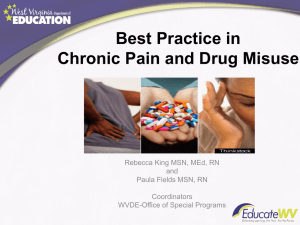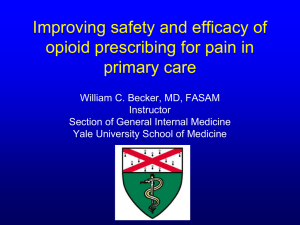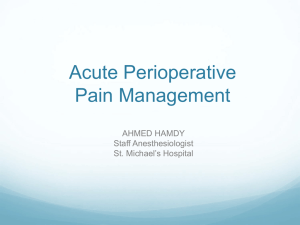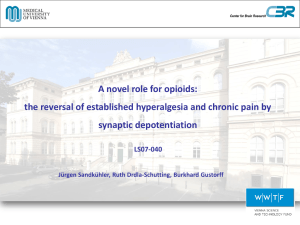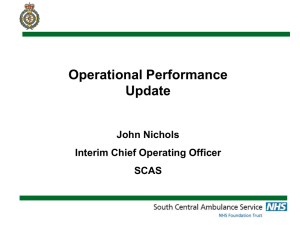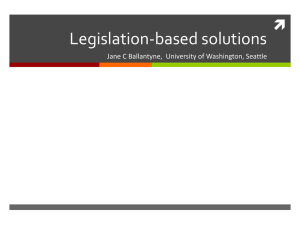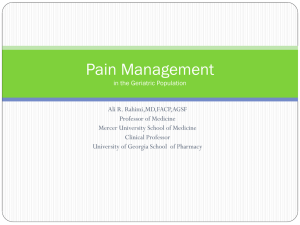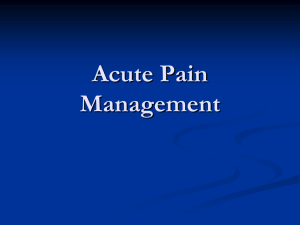Chronic Pain & the Epidemic
advertisement
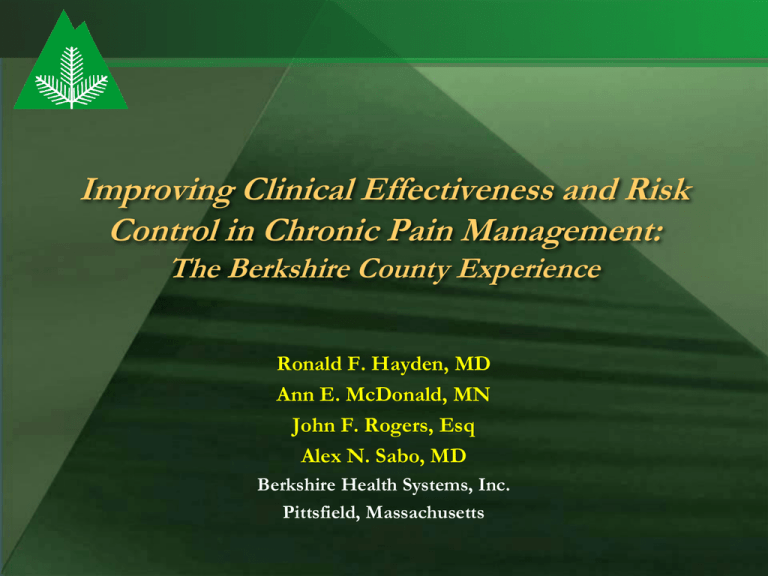
Improving Clinical Effectiveness and Risk Control in Chronic Pain Management: The Berkshire County Experience Ronald F. Hayden, MD Ann E. McDonald, MN John F. Rogers, Esq Alex N. Sabo, MD Berkshire Health Systems, Inc. Pittsfield, Massachusetts Disclosure The content of this presentation does not relate to any product of a commercial interest. Therefore, there are no relevant financial relationships to disclose for: Ronald F. Hayden, MD Ann E. McDonald, MN John F. Rogers, Esq Alex N. Sabo, MD Factors Fueling Berkshire Community Pain Management Program Ann E. McDonald, MN Berkshire Community Pain Management Project Berkshire Health Systems, Inc. Berkshire County— Including Area Hospitals And Cities Berkshire County Surface Tranquility Sub-surface Tremors Schedule II Opioid Poisonings Per 100,000 2005 Massachusetts Opioid Poisoning Cases Rates per 100,000, by Town 2005 Rates per 100,000 population (quintiles) Rates per 0 100,000 population (quintiles) 0.01 0 - 18.01 18.02 00.01 -- 41.63 18.01 41.64 62.73 18.02 - 41.63 62.74- 225.51 41.64 - 62.73 62.74- 225.51 BMC has > 40 survived overdoses annually, mostly oxycodone and hydrocodone combinations Sub-surface Tremors Schedule II Opioid-related Hospitalizations Per 100,000 – 2005 Sub-surface Tremors Unintentional overdose death rates by state, 2006 – over 16,000 deaths annually 11.6 7.6 10.4 1.1 4.5 9.8 6.9 6.9 4.9 4.0 16.1 12.5 7.6 9.9 16.5 8.0 8.3 3.1 12.1 9.5 10.0 11.5 18.6 10.8 7.5 14.2 19.4 11.0 15.3 6.2 10.2 14.1 11.0 8.9 10.7 8.4 NH VT MA RI CT NJ DE MD DC 7.7 7.9 MA – 2006 – 13 2005 – 10.6 2002 – 9.2 15.4 12.5 9.9 Rate per 100,000 population 6.4 1.1-8.4 Len Paulozzi, MD, MPH, Centers for Disease Control and Prevention, 2009 8.5-11.4 9.4 10.0 13.0 15.2 10.0 8.6 8.6 12.3 16.4 11.5-19.4 Sub-surface Tremors Relationship Between Opioid Sales And Drug Poisoning Mortality MA LJ Paulozzi, GW Ryan , American Journal of Preventive Medicine, 2006 Sub-surface Tremors • Increasing reliance on pain specialists for chronic pain medication management instead of PCPs • Pharma industry information suggesting +2 million Schedule II doses in 2005 in Berkshire County • Schools and law enforcement reporting increased discovery of diverted pain medication prescribed by local providers • DA concern about pain medication abuse and opioids as gateway to heroin use • Anecdotal evidence of “doctor shopping” • Addiction specialists seeing greater use of analgesics Doses of Schedule II Opioids Dispensed in Berkshire County: 1996-2008 3,500,000 3,094,911 3,168,950 3,000,000 Total Doses Dispensed 2,851,443 2,936,420 2,500,000 1996-2005 an increase of 18% annually 2,000,000 2,489,265 2,175,883 1,806,831 1,533,600 1,500,000 1,057,279 1,250,047 1,000,000 661,987 748,463 500,000 578,309 0 Fiscal Year 1996-2008 2006-2008 inc 4% yr Magnitude of Local Pain Management Risk Control Issue Estimated ratio of Schedule II to Schedule III and IV opioids is 1:4.4 3,168,950 Schedule II opioid pills in 2008 Total 13,943,380 opioid pills prescribed 103.3 tabs per each of 135,000 residents MDPH Prescription Monitoring Program, 2009 Schedule II Opioid Prescriptions in Berkshire County 1996-2008 60,000 Prescription Numbers 50,000 40,000 30,000 20,000 10,000 0 FY 1996-2008 Schedule II Prescriptions per Individual in Berkshire County: 1996-2008 Estimated prescriptions /individual Estimated prescriptions/ individual 4.00 4.00 3.39 3.50 3.50 3.02 3.21 2.79 3.00 3.00 2.60 2.50 2.50 2.00 2.00 2.36 3.25 3.19 2.69 2.43 2.22 1.50 1.50 1.00 1.00 0.50 0.50 0.00 0.00 3.33 Fiscal Years Fiscal Years1996-2008 1996-2008 3.03 Questionable Opioid Activity in Berkshire County: 1996-2008 Questionable Activity with Questionable Individualswith # of Activity Individuals # of 160 160 140 140 139 120 120 95 100 100 89 94 76 80 80 64 51 60 60 40 40 53 58 39 45 39 20 20 00 FiscalYears Years 1996-2008 1996-2008 Fiscal 83 Linear Relationship Between Opioids Dispensed and. . . • Deaths – tripled in the US between 1999 and 2007, now more than 1000 deaths each month in US • Overdoses – major culprit is oxycodone, most are unintentional and occur in relatively young individuals • Hospitalizations – secondary to rescue and treatment of addiction, risk of addiction after treatment for several months or longer is 35% (BMJ, 2011) • Impaired Lifestyle – isolation, loss of function, motivation • Worse Outcomes - most commonly studied in LBP, leading to high rates of long term disability Prescriber Role in Both Proper Control and Misuse Alex N. Sabo, MD BMC Department of Psychiatry and Behavioral Sciences Berkshire Health Systems, Inc 18 Project Thesis • Health care entities and clinicians uniquely situated to lead effort among community-based stakeholders to: – Improve quality/availability of care for patients with chronic pain through provider and patient education with adoption of strategies to improve safety in prescribing – Improve individual and public health and safety by reducing misuse and diversion of prescription pain medication – Reduce expense of care, productivity loss and other societal costs of dependence and addiction through prevention and early identification Twin Project Goals Assuring safe and effective treatment of those suffering from acute and chronic pain in Berkshire County while preventing individual and community harm from misuse and diversion of prescribed pain medication Participating Community Organizations Community Treatment Providers: Physicians and other clinicians Dentists Pharmacies Criminal Justice: MA Probation Services BC Sheriff ’s Office BC District Attorney Police Departments BC Drug Task Force Community Stakeholders: Public and private schools Three community coalitions Massachusetts Dept of Public Health: Drug Control Program Prescription Monitoring Program Academic Affiliations: Brandeis University Tufts University First Barrier to Safe Prescribing: Lack of Effective Communication Criminal Justice System Regulatory Agencies: DPH Community Agencies: Schools Substance Abuse Providers Silo’d Treatment and Communication Primary Care Providers Emergency Medicine Providers Mental Health Providers Pain Providers Goal: An Integrated Community Program Optimize treatment planning and EMR communication Primary Care MA DPH PMP Berkshire County Community Pain Management Pain Specialist Mental Health Emergency Medicine 23 Pain Care Resource Manual Tools • Universal Precautions – – – – Clarify expectations Improve patient care and patient safety Reduce stigma Contain risk • Diagnosis and Treatment Algorithms – Reinforce evidence-based medicine in pain management • Opioid Medication & Risk Information • Treatment Agreements – – – – Medication benefits and risk informed consent document Treatment goals and expectations set One prescriber/one pharmacy Appropriate communication among all co-managers of care Pain Care Resource Manual Tools • Urine Drug Screening Advice and Forms – 3x annually – Liquid chromatograph/mass spectrometry technology added in 3Q 2008 – Improves patient safety by identifying non-compliance – Aids prescriber risk assessment • • • • Opioid Risk Screening Tools: SOAPP & COMM Multidisciplinary Assessment Program Description Regulatory Information Community Resources, including substance abuse services Key Project Components • Provider Education – Pain Care Resource Manual – Encouragement of BioPsychoSocial Model for Addressing Persistent Pain – County-wide Medical Conferences: 2005, 2006, 2009-10 – Introduction of Content into Residency Program Training – Education of entire care team, including MAs and practice administrators, through biannual meetings on implementation Key Project Components • Integration of Care – – – – – – Information Technology: Optimizing EMR Monthly Multidisciplinary Treatment Planning Conferences Integrated Pain Treatment Pilot Program – CBT and Yoga Psychologist Added to the Pain Treatment Program Wrap-around Buprenorphine Treatment Residency QI program to measure and improve use of quality of care tools • Community Assistance and Awareness • Safe Medication Disposal Initiatives • Partnerships with MA DPH and Research Institutions Information Technology Tools • Flag Electronic Medical Records – Co-management issues with opioid medication • Existence of chronic pain and medication contracts are noted in Patient Summary Screen • Substance Use Alerts on Aberrant Behavior are noted in Patient Summary Screen; history/risk of abuse • Automatic system for maintaining currency of contract notation • Create Pain Management Plan note to allow more effective comanagement of care • Identify “doctor shoppers” through multiple prescribers/visits • Study e-Prescribing of Controlled Substances in ambulatory setting • Track individual cases and assemble aggregate outcomes Monthly Multidisciplinary Treatment Conference • Goal: Efficiently communicate coordinated treatment plan for challenging patients across provider network • Plan identified in EHR problem list as “Pt Specific Treatment Plan (See MTP 01/01/11)” • Participants include: – – – – – Interventional Pain Physicians ED Chair Psychiatrist with addiction specialty Psychologist Ideally – PCPs, neurologists, rheumatologists and mental health providers already involved in care Community Assistance and Awareness: Parent Education: 1/5 Community Assistance and Awareness: Partnership with Criminal Justice System Collaboration with District Attorney’s Office • Measure local opioid poisonings and deaths, • Annual “State of the Streets” report • 3 Drug Take Back Programs Facilitation of Pre- and Post-trial Substance Abuse treatment Berkshire Partnership in Care Program • Pilot program with Probation Services in central and southern county to better manage care of probationers at risk for prescription medication abuse The “Oxy” Free ED: An New Approach to Prescribing Controlled Substances in the BHS Emergency Departments Ronald F Hayden, MD, FACEP BMC Department of Emergency Medicine Berkshire Health Systems, Inc. Characteristics Of All EDs That Create Environment of Opioid Prescribing Risk • • • • Open continuously Often no existing physician-patient relationship Fragmented connection to primary prescriber Patients become aware of variance in prescribing patterns, plan visits • Busy environment, easier to write script than start education on safety Why an Oxy Free ED? • The “Oxy Free ED” –a much needed concept to help EDs manage care effectively but also cope an epidemic of opiate misuse, addiction and death occurring over past 15 to 20 years. • Need to prescribe analgesics in manner consistent with the medical evidence, mindful of individual and social risk. • The statistics speak for themselves . . . Sources of Opioid Analgesics Setting Type Emergency department Primary care office % Distribution 39% 31% Medical specialty office Surgical specialty office Hospital outpatient department 13% 10% 7% Source: National Center for Health Statistics. Medication therapy in ambulatory medical care: United States, 2003-04 36 Goals of Oxy-Free ED • For acute pain complaints: apply accepted guidelines to effectively treat pain but avoid medications that pose risk of diversion, abuse and addiction. • For chronic pain complaints: clarify the role of the ED at presentation, emphasizing coordinated care, information sharing, drug screening and concern for addiction and other risk issues. • Reduce the unnecessary volume of prescription opioids in our community…thereby reduce death, overdose and addiction Principles of “Oxy” Free ED • Acute pain should be treated promptly and appropriately: – Most often non opioid analgesics or schedule III opioids are sufficient – If opioids prescribed, limit discharge medications – If possible, direct communication with primary doctor, including record of visit • Acute exacerbations of chronic pain: Appropriate for treatment in ED? – When urgent treatment necessary—urine drug screen and contact with primary doctor before any prescriptions (limited) are given. • Chronic pain is multifactorial; opioids only small part of care plan – Opioids often not indicated or appropriate – ED management of one small component of overall treatment regimen often ineffective or dangerous • Writing unnecessary opioid script is easy, addressing issue is harder. BHS Emergency Department Guidelines for the Management of Chronic Pain Complaints We Care: To improve your safety and the quality of your care, the BHS Emergency Departments will follow these guidelines in prescribing medication for the treatment of pain. First Principle Pain is a significant medical condition warranting prompt attention and intervention for its relief in the most effective and safest manner feasible: • The Emergency Departments will promptly and effectively address complaints of acute and chronic pain of all patients and, when drugs are appropriate, provide the right drug in the right dosage and for the right duration. Second Principle To prevent the risks of uncoordinated care, one provider should manage all opioids (narcotics) prescribed for chronic pain: • Opioid medications have risks associated with dosage and interaction with other medications, therefore, it is critical to patient safety that one provider coordinate all prescribing. Any exception will require urine drug screen and direct contact with your regular doctor. Third Principle • To avoid the risks associated with the administration of injectable opioids, we will rarely provide these medications for the treatment of chronic pain: • Pain specialists discourage the use of pain medication shots for the treatment of chronic pain as they lead to increase tolerance to the these medications. Fourth Principle In order to avoid the risks of overmedication and other misuse, we will not provide replacement prescriptions that are lost, destroyed or stolen. • Any necessary replacement prescription must be obtained from the original prescribing doctor. Fifth Principle Long-acting or controlled-release opioids (such as OxyContin, oxycodone, fentanyl patches and methadone) are designed to be part of plan for managing chronic pain. We will not prescribe them for managing a chronic pain complaint. These medications need a primary care or pain specialist supervision. • We can assist in managing acute pain either with non-opioid treatment or a short course of opioid medication in appropriate situations. Sixth Principle In order to better assure safe, effective coordination of care, we will share relevant information with doctors involved in caring for the patient. • We will appropriately share information with your doctors. Seventh Principle Patients with complex pain conditions often require treatment by many specialists. These patients are best managed with a coordinated plan of care. This care plan improves safety and effectiveness. • We may develop a patient treatment plan on your condition and record this in the medical record. Summary and Rationale The Departments will rarely prescribe those medications most associated with abuse or addiction: e.g., Percocet, OxyContin, Dilaudid, MS Contin, Duragesic (fentanyl). The Oxy Free ED • Do the right thing and provide acute pain relief promptly and in proportion to injury using a short course of medications. • Reduce dependence, addiction and overdose risk with less opportunity for diversion and non-medical use. • Reduce the high utilization of the ED for chronic pain complaints and engage primary physicians and pain specialists. • Improve better outcomes for patient, family and the community. Key Legal Issues ∆ Early Signs of Berkshire Project Impact John F. Rogers, Esq Vice President and General Counsel Berkshire Health Systems, Inc Key Legal Issues • Patient Privacy and HIPAA Basics – Most states recognize that duty of confidentiality exception in cases of serious danger to patient or others • Narrower exception in psychiatric care (Tarasoff cases) – Implied consent in co-management of care – HIPAA Privacy Rule • • • • OCHA NOPP TOP Crime on Premises – Federally funded treatment programs (“Part 2 Facilities”) Key Legal Issues • Privacy Exception: Reporting Crime on Premises – All states have laws similar to M.G.L. c. 94, §33 making it a crime to: “knowingly or intentionally acquire or obtain possession of a controlled substance by means of forgery, fraud, deception or subterfuge, including but not limited to forgery or falsification of a prescription or non-disclosure of a material fact…..” Attempts to commit a crime are also a crime. Key Legal Issues • Patient Autonomy and Limits of PatientDirected Care – Most states recognize the patient right to give/withhold consent ≠ right to inappropriate or futile care, care outside boundaries of accepted medical practice • Liability Coverage Early Signs of Project Impact: Adoption of Best Practices • 750 Pain Contracts posted in EMR from 11 Practices • Steadily increasing volume of Urine Drug Screens • 166 prescribers participating in EPCS study • Prescriber and administrator enthusiasm for ongoing education (“new community ethic”) • Enrollment in PMP Single Patient Look-up • ED provider prescribing modifications Early Signs of Project Impact Increased Use of Prescription Monitoring Program • Prescription Monitoring Program authorized in 48 states, operating in 35 – Pharmacies transmit prescribing data to state repository—either public health or public safety – Operated on state-by-state basis • First in 1972 (PA); 36 added since 2000 • Limited interconnectivity • National All Schedules Prescription Electronic Reporting Act of 2005— – Unfunded 2006-2008; $2M in 2009 and 2010 (grants in 13 states – Would annually collect 673 million prescriptions from 65,000 DEA-registered pharmacies accessible by 1.2 million DEA-registered prescribers Early Signs of Project Impact Increased Use of Prescription Monitoring Program • PMPs Originally Funded through Department of Justice – Law enforcement focus: “doctor shopping”, prescription forgery, indiscriminate prescribing – Many state PMPs housed in law enforcement agencies – Data base not used to target subjects for investigation and only available to law enforcement in connection with existing investigation concerning specific prescribers or customers • More Current Approach, Including NASPER Focuses on Public Health Potential of PMPs Early Signs of Project Impact Increased Use of Prescription Monitoring Program The Kentucky PMP Experience Est. 1999 CS Dispensers: 1500 Scripts annually: 8.2 million Prescribers Pharmacists 92% 1% 1% 3% 3% Internet based 5,500 report requests per week <5 second response time Licensing Boards Law Enforcement Others Early Signs of Project Impact: Slowing Annual Increase in Total Schedule II Doses Slope-1.2% Slope-10% Slope-3.69% Slope-18% Slope- 9% 2008 PMP data showed statistically significant reductions in scripts per pt and doses per script. Early Signs of Project Impact: Providers Beginning to Limit Prescriptions and Doses Per Prescription The difference between the 05-08 projected total doses and the recorded 05-08 total doses is 491,050 doses. Early Signs of Project Impact: Program Success with Coordinated, Planned Care (Buprenorphine Wrap Around Program) 90% 80% 70% p<0.05 60% 50% 80% 40% 30% 20% 42% 10% 0% Pretreatment (Measured as return to work or school) After Treatment Was Initiated Early Signs of Project Impact: Individual Patient Success with Coordinated, Planned Care • • • • • Single male, 30’s College graduate Unemployed 4 years Chronic pain syndrome 3 + Berkshire doctors providing opioids and benzodiazepines • 28 hospital visits in 33 months • Family terrified he will die • Began drinking age 8 • Misusing opioids > 10 years • Polysubstance dependence • Multiple overdoses; near fatal experiences • Multiple suicide attempts • Variety of dangerous behaviors involving police Early Signs of Project Impact: Individual Patient Success with Coordinated, Planned Care • Care coordinated with Emergency Department, Psychiatry and Substance Abuse Services • Admitted to inpatient psychiatry unit • Tapered off opioids and benzodiazepines • Multiple family and treatment meetings • Seamless transfer to buprenorphine wrap-around program Early Signs of Project Impact: Individual Patient Success with Coordinated, Planned Care Average Monthly Cost of Care Pre-treatment: $5258 During 1st year of treatment: $1566 During 2nd year of treatment: $700 Carlen Robinson, 32 August 9, 1973 - November 11, 2005


